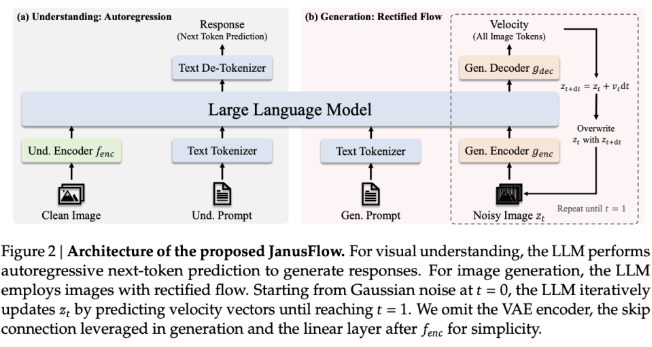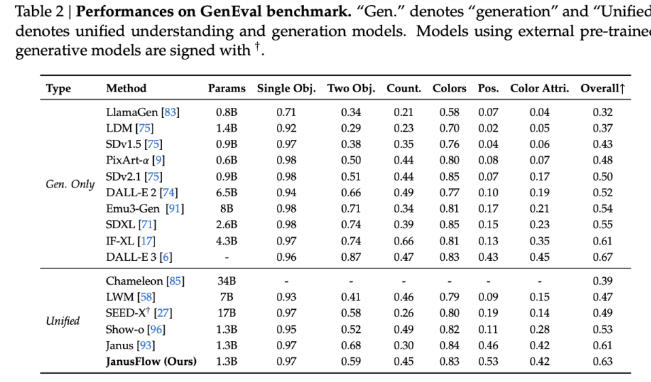The fields of artificial intelligence image generation and understanding are undergoing rapid development, but the performance of existing models in image generation and understanding tasks is inefficient and difficult to integrate. DeepSeek AI launched JanusFlow framework aims to solve this problem, enabling more efficient and concise multimodal AI processing by integrating image understanding and generation into a unified architecture.
Despite rapid progress in the field of image generation and understanding driven by AI, significant challenges remain that hinder the development of a seamless, unified approach.
Currently, models focusing on image understanding tend to perform poorly in generating high-quality images and vice versa. This task-separated architecture not only increases complexity, but also limits efficiency, making processing tasks that require understanding and generation cumbersome. Furthermore, many existing models rely too much on architecture modifications or pre-trained components when performing any function effectively, which leads to performance trade-offs and integration challenges.
To solve these problems, DeepSeek AI launched JanusFlow, a powerful AI framework designed to unify image understanding and generation. JanusFlow solves the previously mentioned inefficiency problem by integrating image understanding and generation into a unified architecture. This novel framework adopts a minimalist design, combining autoregressive language model with rectified flow—a state-of-the-art generative modeling method.

By eliminating the need for standalone LLM and generated components, JanusFlow enables tighter functional integration while reducing architectural complexity. It introduces a dual encoder-decoder structure that decouples understanding and generation tasks and ensures performance consistency in a unified training scheme by aligning representations.
In terms of technical details, JanusFlow integrates corrected flow with large language models lightweight and efficiently. The architecture includes a standalone visual encoder for understanding and generating tasks. During training, these encoders are aligned with each other to improve semantic consistency and make the system perform well in image generation and visual comprehension tasks.
This decoupling of the encoder prevents interference between tasks, thereby enhancing the capabilities of each module. The model also uses classifier-free boot (CFG) to control the alignment between the generated image and text conditions, thereby improving image quality. Compared to the traditional unified system using diffusion models as external tools, JanusFlow provides a simpler, more direct generation process with fewer limitations. The effectiveness of this architecture is reflected in its ability to match or exceed the performance of many task-specific models in multiple benchmarks.
The importance of JanusFlow is its efficiency and versatility, filling a key gap in multimodal model development. By eliminating the need to generate and understand modules independently, JanusFlow enables researchers and developers to handle multiple tasks with a single framework, significantly reducing complexity and resource usage.
The benchmark results show that JanusFlow scored 74.9, 70.5 and 60.3 on MMBench, SeedBench and GQA, respectively, outperforming many existing unified models. In terms of image generation, JanusFlow surpassed SDv1.5 and SDXL, with the MJHQ FID-30k scored 9.51 and the GenEval scored 0.63. These metrics demonstrate its superior ability to generate high-quality images and process complex multimodal tasks, requiring only 1.3B parameters.

Conclusion is that JanusFlow has taken an important step in developing a unified AI model that can simultaneously understand and generate images. Its minimalist approach—focusing on integrating autoregressive capabilities with corrective flow— not only improves performance, but also simplifies the model architecture to make it more efficient and accessible.
By decoupling the visual encoder and aligning the representations during training, JanusFlow successfully bridges the image understanding and generation. As AI research continues to break through the boundaries of model capabilities, JanusFlow represents an important milestone towards creating more versatile and versatile multimodal AI systems.
Model: https://huggingface.co/deepseek-ai/JanusFlow-1.3B
Paper: https://arxiv.org/abs/2411.07975
Points:
JanusFlow is a unified framework that integrates image understanding and generation into one model, improving efficiency and operability.
The framework outperforms multiple existing models in multiple benchmarks, especially in generating high-quality images.
JanusFlow avoids inter-task interference and simplifies the overall architecture by decoupling the visual encoder.
In short, with its efficient architecture and excellent performance, JanusFlow provides a new direction for the development of multimodal AI models and lays the foundation for more powerful AI applications in the future. Looking forward to its application and development in more fields.